(in english) The Hellénist Victor Bérard
Victor Bérard
Victor Bérard, born in 1864, Hellenist, diplomat and politician, devoted his life to finding the sites visited by Ulysses. He made a translation of the Odyssey, and wrote a book entitled "In the wake of Ulysses".
The preconceived ideas of this Hellenist led him to limit his research to the Mediterranean, and his conclusions passed into the collective memory: the Strait of Messina would be the site of Charybdis and Scilla, the country of the Lotophagi would be in Tunisia, the country of the Lestrigons in Corsica in Bonifacio, etc.
He actually found suitable landscapes, more or less consistent with the description made in the Odyssey, inside this sea.
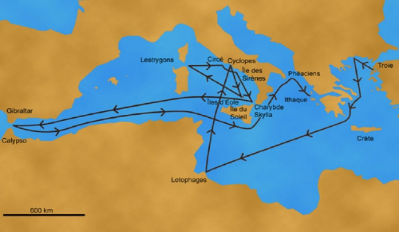
But Victor Bérard did not take into account the indications of time yet inscribed in the text in the same way as the descriptions, which leads, according to his interpretation, to incoherent speeds of movement, or to passages deliberately ignored.
Let's see what is the interpretation of V. Bérard:
From Troy, Odysseus and his companions (12 boats) go to the land of the Kikones (this is present-day Macedonia). They plunder the city and kill the warriors. They are repulsed by warriors from within.
The north wind (Boreas) pushes them to Cape Malea.
From Cape Malée to the land of the Lotophagi.
After passing Cape Malea, the north wind prevented them from sailing up to Ithaca, and a nine-day storm drove the fleet beyond Kythira. On the tenth day, they arrive in the land of the Lotophagi
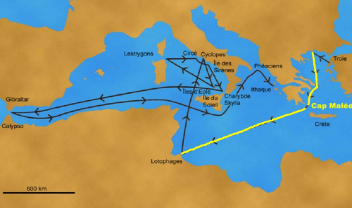
The land of the Lotophagi is assimilated by V. Bérard to Djerba, which is an island, while Ulysses speaks of a continent.
The duration of the announced trip (9 days), and the imagined journey (588 nautical miles, or 1090 km), assumes a daily average of 65.3 miles, ie a speed of 2.7 knots. This seems very little for ships pushed by the storm.
From the land of the Lotophagi to the land of the Cyclops.
Leaving the land of the Lotophagi, they arrive in the "land of round eyes" which are named "The Cyclops". (Cyclops have always been equated with volcanoes.)
In front of this island, says the Odyssey, a "small island": excellent land, watered meadows, soft, suitable for vines and wheat. This island is populated only by goats.
Ulysses, leaving his troop there, goes to the main island with some warriors, visiting "a high cave", lair of a monster with one eye: Polyphemus
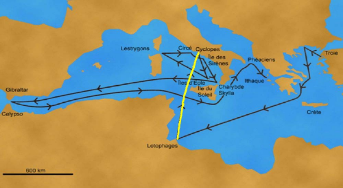
The arrival site (Vesuvius) designated by V. Bérard is not an island. We do not see this small fertile island that is in front (Ischia, cited, does not correspond at all to the description). As for the "land of round eyes", there is only one volcano.
From the land of the cyclops to the island of Aeolus.
After getting rid of Polyphemus, they leave to reach the island of Eole: an island that floats, says the Odyssey, with bronze walls, a polished rock that points to the sky.
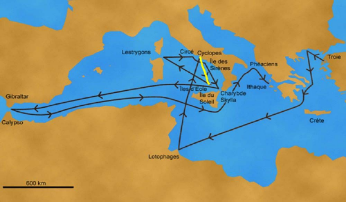
The Aeolian Islands might be fine (maybe because of their name?), but there are 17 of them, which is Eole's abode?
Round trip to Ithaca.
The odyssey says: When they leave, after a month of sojourn in which they were well received by Aeolus, they intend to return to Ithaca.
Aeolus gives Ulysses a bag containing all the winds, to facilitate his journey. But the companions of Odysseus do not know what this otter contains, and are jealous of this gift.
The journey lasts nine days, then the companions of Odysseus open the bag, to see this gift.
The winds are released, and a new storm brings them back to the island of Aeolus.
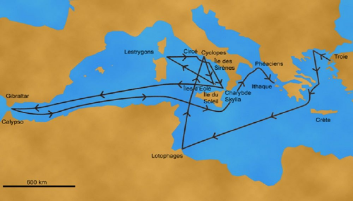
Bérard considers this passage of the text to be a poetic embellishment.
It is true that this trip to Ithaca (nine days announced) would be excessively slow: 1.5 knots
It would impose a passage through the Strait of Messina (Charybdis and Scylla according to him), but the text does not mention it. And the duration of the return – nine days too, pushed by the storm and which would make a hell of a bend to cross the Strait of Messina does not seem well compatible with the locations presented.
It does not fit well, and V. Bérard ignores this episode.
From the island of Eole to the land of the Lestrigons
Aeolus, as a result of what happened to them, thinks them cursed by the Gods, and drives them away.
They leave this island, to sail six days and six nights.
On the seventh day they arrive in the Lestrigon country.
In this country, the nights are short: the shepherd who leaves with his flocks greets another shepherd who returns.
The days are long: a brave man could earn double pay
The port, "well known to sailors", is encased between two cliffs and very elongated.
The Lestrigons are in a bad mood and throw stones at boats.
The fleet is destroyed, only Ulysses' ship escapes
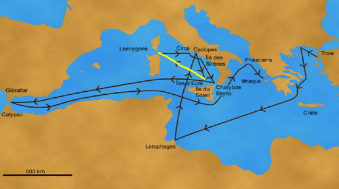
Bérard locates the Lestrigon country in Sardinia or Corsica, by identifying the port described with Bonifaccio. The route described (308 miles) is covered in six days! ... Average 2 knots !... As for the length of the days, even in summer, it would not allow to earn double salary.
The island of Circe.
Ulysses and his remaining companions, leaving the other destroyed boats there, reach the island of Aiaié, home of Circe.
Ulysses encounters a deer ten horns.
From the summit near the anchorage, we see a low plain surrounded by sea on all sides.
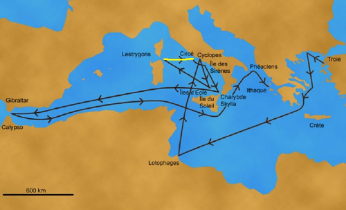
Monte Circeo is not located on an island. V. Berard who chose this site on the basis of his name, defends himself by saying that the marshes present between the mount and the land could have been confused with the sea! For a Ulysses "with a thousand tricks", the confusion is not credible.
Visit to the Underworld, omitted by V. Bérard
When spring returned, Circe told Odysseus to make a trip to the Underworld, to consult the soothsayer Tiresias who was there.
The journey begins with Boreas, the north wind, and continues to the confluence of several rivers of the underworld (the Acheron and the Pyriphlegethon, the Styx and the Cocytus).
Odysseus meets many disappeared, and collects the predictions of the soothsayer Tiresias.
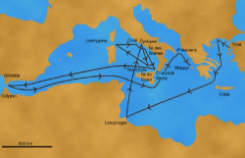
Victor Bérard outright ignores this passage of the Odyssey.
The Sirens, Charybdis and Scylla
Returning from the Underworld to Circe, Ulysses considers the return journey.
Circe warns him against the Mermaids, birds with charming voices.
Then she describes two routes:
1/ The Stones of the Pinnacle, exposed to the ocean. Only the Argo was able to pass these pitfalls.
2/ The two pitfalls of Charybdis (which swallows black water...) and Scylla (which houses a monster.
Victor Bérard proposes the Strait of Messina for the site of Charybdis and Scylla and the island of Ischia to host the sirens.
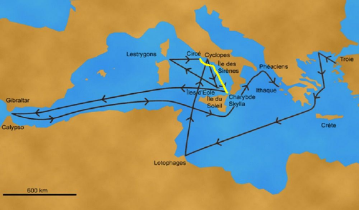
Comments: But we do not see in this stage the route "exposed to the Ocean". And the supposed places are not very much in line with the descriptions.
Trident Island
Past the Sirens, and Charybdis and Scylla, we arrive at the island of Trident called the Odyssey. In fact. the term "trident" is an elegant translation made by V. Berard. The original text speaks of an island with three points: the Trinacrie
There are herds of cows and sheep, which must not be touched (They belong to the Gods)
The boat is blocked by the south winds (Notos), which prevent it from taking to the sea.
The companions of Odysseus, driven by hunger, kill an ox of Apollo.
The Gods are angry and punish offenders: the boat is struck by lightning
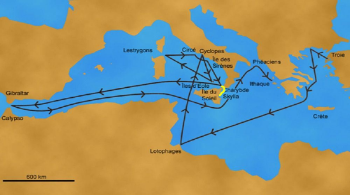
Comments: The "three-pointed island" is understood by Victor Bérard as a "triangular island". But to see it like that, you need a map, and it doesn't seem like you can do that.
On Sicily:
Bérard therefore locates the "island of the trident" in Sicily. This territory is supposed to be distant in the story of the Odyssey. It was in fact very well known to the contemporaries of Ulysses. Odysseus himself, on his return, meets his father Laerte; He tells him a false story to hide his identity.
In this speech, he speaks of a "return from Sicily" (page 871 of the edition of the Pléiade), and further away from a servant – the wife of Dolios, servant of Laerte – under the name of "the old woman of Sicily" (page 873), and he does not speak of Trinacrie.
In fact, Sicily was part of the well-known world of the Achaeans.
Calypso
Struck down by Zeus for killing Apollo's oxen, Odysseus passes the pitfalls of Charybdis and Scylla, and drifts for nine days, clinging to the wreck of the boat.
He arrives on an "ocean island": the land of Calypso
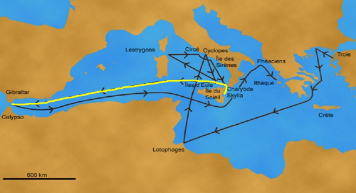
Comments : This drift ending at Gibraltar would cause Ulysses to travel 1074 miles in nine days, which corresponds to a drift speed of 4.97 knots. This is much more than the speeds of other trips, including those pushed by a storm!
Again, the speeds are not credible. As for "The Ocean Island", no trace !!!
The return journey
After a year of stay, the Gods are worried and send Hermes to ask Calypso to free Odysseus.
Odysseus builds a boat, then makes a seventeen-day journey home.
He is alone, all his companions have disappeared.
In fact, he arrives in Scheria, among the Phaeacians.
It is there that he tells his journey to the king of the island Alcinoos, father of Nausicaa.
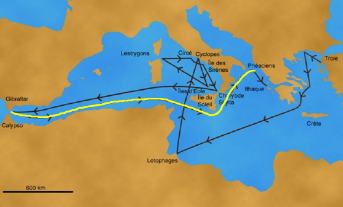
Comments: New inconsistency of speeds: this return trip, which lasts 17 days, is therefore carried out, on a boat, at an average of 3.2 knots. It's slower than the drift, clinging to a wreck, that brought him to Calypso!
The departure from Calypso begins towards the south ("He was looking at the Pleiades", says the text, and this constellation is located towards the south"). The direction of the Pleiades is not that taken in this interpretation.
A découvrir aussi
- (in english) The Iliad and the Odyssey
- (in english) Different interpretations & Speed of boats
- (in english) The Odyssey according to Gilbert Pillot
